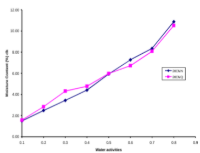Shelf-life study of co-milled carrot with fermented quality protein maize (QPM) using sorption isotherm
Main Article Content
Abstract
Shelf-life of a food product is the time, it stays qualitatively acceptable and safe for consumption. One of the methods of estimating shelf-life of food is by the use of food sorption isotherm. This study is aimed at determining effect of varietal difference on the shelf-life of co-milled carrot and fermented maize (ogi) flour using BET monolayer model. Two samples of maize varieties; a yellow colored (TZE-YPOP-DT-STR-QPM) variety was studied in comparison with yellow coloured normal maize (SUWAN-ISR). These were co-milled separately with 40% carrot. Adsorption isotherm was used to determine the shelf life of the co-milled flour samples at room temperature over a range of water activities (aw) of 0.1 to 0.8. The result for 20CMN and 20CMQ showed that Equilibrium Moisture Content (EMC) increases with aw(1.50-10.87 and 1.57-10.52, respectively) at room temperature. Also, amount of water absorbed which is directly proportional to EMC increased with increased water activity. Sample 20CMQ absorbed more moisture than sample 20CMN at low water activity (between 0.1-0.5) and vice-versa at aw above 0.5. Incidentally, the estimated BET monolayer for 20CMN (3.43) is lower than 3.52 obtained for 20CMQ. It is established that at high relative humidity, flour from normal endosperm maize will deteriorate faster than that of QPM flour, meaning that the shelf-life of QPM flour will be longer than that made from normal endosperm.
Downloads
Article Details
Issue
Section

This work is licensed under a Creative Commons Attribution-NonCommercial-ShareAlike 4.0 International License.
How to Cite
References
Abdullah, N., Nawawi, A. & Othman, I. (2000). Fungal spoilage of starch-based foods in relation to its water activity (aw). Journal of Stored Products Research, 36: 47-54.
Akanbi, C.T. & Oludemi, F.O (2003): Effect of processing and packaging on the lycopene content of tomato products. International Journal of Food properties, 7(1): 139-152
Al-Muhtaseb, A. H., McMinn, W. A. M. & Magee, T. R. A. (2004). Water sorption isotherms of starch powders Part 1: mathematical description of experimental data. Journal of Food Engineering, 61: 297–307.
Bell, I. N. & Labuza, T. P. (2000). Moisture sorption: Practical aspects of isotherm measurement and use. 2nd Ed. (pp. 14- 32, 57-69). St. Paul, MN: American Association of Cereal Chemists.
Chen, L. H. & Lin, C.W. (2002). Factors affecting the water holding capacity of fibrinogen/plasman protein gels optimized by response surface methodology. Journal of Food Science, 67(7): 2570-2582.
Chuzel, G. & Zakhia, N. (1991). Adsorption isotherm of gari for estimation of packaged shelf life. International Journal of Food Science and
Technology, 26: 583-593.
Kinsella, L. E. (1976). Functional Properties of Proteins in Foods. A Survey. Critical Review in Food Science and Nutrition. 7: 219-232.
Kumar, M., Kumar, S. & Kaur, S. (2011). Investigations on DNA protective and antioxidant potential of chloroform and ethyl acetate fractions of Koelreuteria paniculata Laxm. African Journal of Pharmacy and Pharmacology,5(3): 421-427.
Kuye, A. & Sanni, L. O. (2002). Analysis of the equilibrium Moisture Sorptiondata for “lafun” and Soy flour. Proceedings of the 13th International Drying Symposium (IDS; 2002). Beijing, China 3: 1481
Oladeji, B. S., Akanbi, C. T. & Ibironke, S. I. (2014). Physico-Chemical and Nutritional Evaluation of Co-Processed Fermented Yellow Maize Ogi (an Infant Diet) and Carrot Blends. Annals. Of Food Science and Technology, 15(1):92-102.
Peng, G., Chen, X., Wu, W. & Jiang, X. (2007). Modeling of water sorption isotherm for corn starch. Journal of Food Engineering, 80: 562–567.
Perry, R. H. & Green, D. (1984). Chemicalnginer‟s Hanbook. 6th Ed. McGraw Hill. Int. Pp. .3-65.
Rahman, S. (1995). Food properties handbook. Florida. CRC Press, Inc. In: Rahm D.H. (2010). Carotenoids, nutritional supplement, vitamin A. Health and Wellness, available at www.healthandwellness.com
Rahm D. H. (2010). Carotenoids, nutritional supplement, vitamin A. Health and Wellness, available at www.healthandwellness.com
Raji, A.O. & Ojediran, J. O. (2011). Moisture sorption isotherms of two varieties of millet. Food Bioproduction Process, 89 (3): 178-184.
Samapundo, S., Devlieghere, F., De Meulenaer B., Atukwase, A., Lamboni, Y. &Debevere, J. M. (2007). Sorption isotherms and isosteric heats of sorption of whole yellow dent corn. Journal of Food Engineering, 79: 168-175.
Sanni, L. O., Atere, C. & Kuye, C. A. (1997) Moisture sorption isotherms of fufu and tapioca at different temperatures. Journal of Food Engineering, 11: 203-212.
Shindano, J. (2007). Functional properties of white maize meal stored under tropical conditions. Unpublished Dissertation submitted in fulfillment of the requirements for the degree of doctor (PhD) in Applied Biological Sciences: Chemistry. Faculty of Bioscience Engineering, Ghent University ISBN: 978
TAAS, (2008). Quality protein maize for human nutritional security and development of poultry sector in India. Trust for advancement of agricultural sciences the third Dr. M.s. Swaminathan award. Proceeding and highlights of national symposium, NASC complex, Pusa, New, India.
Timmermann, E. O., Chirife, J. & Iglesias, H. A. (2001). Water sorption isotherms of foods and foodstuffs: BET or GAB parameters? Journal of Food Engineering, 48: 19-31.
Wicklow, D. T., Weaver, D. K. & Throne, J. E. (1998). Fungal colonists of maize grain conditioned at constant temperatures and humidities. Journal of Stored Products Research, 34: 355-361.
Yuthana Phimolsiripol & Panuwat Suppakul (2016). Technique in shelf Life Evaluation of Food products; Reference Module in Food Science. https://doi.org/10.1016 /B978-0-08-100596-5.03293-5
Johnson, L. (2000). Corn: The major cereal of the Americas. In: Kulp, K., & Ponte-Jr, J. G. (Eds.). Handbook of Cereal Science and Technology. New York, Marcel Dekker, Inc. Pp. 31-80.


